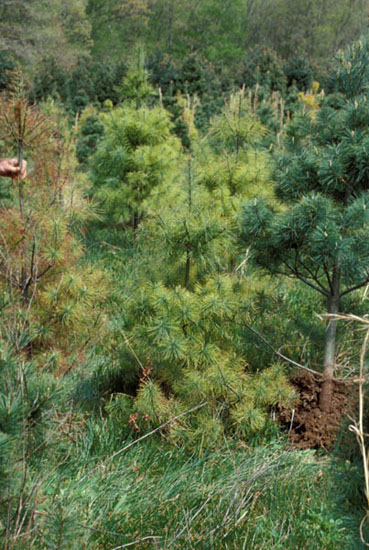Issue 2, April 30, 2010
Dying White Pines
It is a bit early in the season for these calls, but I have already had several inquiries concerning dying white pines. We usually refer to this situation as white pine decline, for want of an exact cause of tree death. Often the complaint is sudden death, in as little as a month's time. Other times the description is pale growth in the winter followed by death of the tree in the spring. Trees affected in the summer appear to die "almost overnight." The last situation is likely related to pine decline hastened by heat and drought stress.
White pines with decline appear yellow or off-color and have sparse looking growth. New needles may be stunted and yellow-brown as in the image. Some people have described a poor root system on affected trees that were removed after declining was apparent. Most people, however, usually cut the trees at the soil line and never inspect roots. Often one or two trees are affected within a row of otherwise healthy white pines. This is not a situation of transplant shock but rather a condition appearing on trees that have been growing on an undisturbed site for many years. The image shows a severely affected white pine on the left, a mildly affected tree in the middle, and healthy white pine on the right.

Samples received at the Plant Clinic over the last decade have been tested for pinewood nematodes, needle and stem blights, and root pathogens. When roots and soil were available, we have also tested for below ground nematodes and evidence of insect feeding. Occasionally we have isolated the Verticicladiella fungus associated with Procerum root decline. We have not associated any consistent biotic factor with the samples we have received. Some researchers working with declining loblolly and longleaf pines in Alabama have seen a possible association in those species with a root boring insect. That has not been observed on the white pines we have seen in Illinois.

It is suggested that many stress factors are involved in the decline of white pines described here. Some suggestions include wet or poorly drained sites, girdling roots, deep planting or mounded mulch, alkaline soil, flooding or drought stress, and possibly involvement of secondary root invading fungi.
There are no cures for infected trees. Try providing water in periods of drought, fertilizing with an acidic fertilizer, and waiting to see whether the tree will respond. This does not seem to be an infectious situation, so waiting for a couple of weeks should not jeopardize other trees. If you see insects on the declining trees, get some help with identification of the species to determine whether treatment is recommended. Once the tree dies, remove it to prevent secondary insect problems that could spread to healthy trees. Consider digging the roots to rule out root rot, root boring insects, girdling roots, and other problems. There are no chemicals suggested or warranted for this problem.--Nancy Pataky
Author:
Nancy Pataky